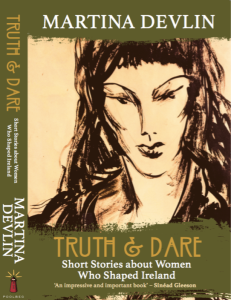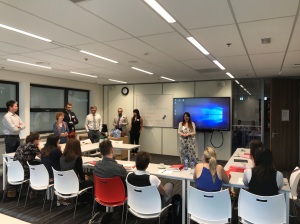Mining the Works of Irish Women Writers, Primary Sources in Archival Collections
Kathleen Williams
As researchers, particularly those exploring Irish women’s writings know, challenges abound! Just as many of the works of Irish women writers have been hidden, so have, or indeed, still are, the primary sources that would foster greater understanding of the women and their work.
Work to create a list of archives for the Irish Women Writers (1880 – 1920) Network website, may lead one to believe that the challenges are overwhelming. A selective list of some of the difficulties involved in exploration of women falling into this category and timeframe includes:
Read MoreAn Appreciation of Winifred Letts
“An Appreciation of Winifred Letts” [1]
Dr. David Clare, Mary Immaculate College, UL

Winifred Letts was born in Salford, in what is now Greater Manchester, in 1882 to an English vicar father and an Irish mother. As a child, she greatly enjoyed the long holidays that her family spent at her maternal grandparents’ house – Knockmaroon, located on the edge of Dublin’s Phoenix Park. These visits instilled a deep love of Ireland in young Winifred, and, when she was 16, she asked her parents to let her transfer from her boarding school in Bromley, Kent to Dublin’s Alexandra College. Her parents acquiesced, and – as a result – Letts joins the important writers Edith Somerville, Mary Manning, and Dorothy McArdle in being an alum of that celebrated south Dublin school. Read More
“A good English factory-girl”: the erased Irishness of nineteenth-century poet Fanny Forrester in Ben Brierley’s Journal
Dr Suz Garrard

Twenty-first century newspapers and media outlets have unparalleled power to not only shape the narratives surrounding superstructural subjects such as immigration, but to construct the social, political, and national identities of the individuals they represent. The power of the media to radically create and recreate public, political selves can be traced back to the explosion of the nineteenth-century newspaper and, in this case, to the massive influx of Irish labourers to industrial English cities.
Truth or Dare: Martina Devlin shares the introduction of her new book
 Leaders. Rebels. Pioneers. Short stories about some of Ireland’s trailblazing women by award-winning writer Martina Devlin.
Leaders. Rebels. Pioneers. Short stories about some of Ireland’s trailblazing women by award-winning writer Martina Devlin.
In this collection we encounter Countess Markievicz back from the dead to cast a disapproving eye over modern Ireland, Hanna Sheehy Skeffington on hunger strike in jail, and Somerville and Ross discussing book business with their London agent Mr Pinker.
Other we meet include a range of activists – Anna Parnell in a pawnshop, Belfast’s Mary Ann McCracken walking her brother to the scaffold, and Dr Kathleen Lynn locking horns with an archbishop.
Authentic and poignant, witty and revealing, Truth & Dare draws on true events to breathe life into an extraordinary cast of women.
Their times were out of step with them – now their time has come
The Mystery of the Disappeared Drishane Archive
By Julie Anne Stevens
Research recalls detective work. The scholar follows clues to solve unanswered questions or to reveal forgotten or overlooked information. The archive gives opportunity to track clues, and while one of scholarship’s pleasures lies in this search, one of its compulsions may arise when a repository’s mysterious unknown does not immediately deliver information. Nonetheless, just like the fictional detective, the researcher expects to discover eventually some central source of knowledge if she or he looks carefully enough and with the right eyes.
Yet with research, revelation does not always happen – especially when the archive goes missing.
Noêlle Ffrench Davies: A Transnational Irish Polymath
S Morgan

Dr. Noēlle Davies (1889-1983), née Ffrench, of Mount Talbot, Co. Roscommon, was a 20th Century intellectual, educationist, litterateur and political activist across Ireland, Wales, Denmark and Europe. Her story is largely unexplored. Using transnational sources, we can trace and assemble her 50 years’ intellectual output. This has four strands: her life-long commitment to education that was both practical and national; seminal intellectual and political collaboration building a modern Welsh nationalism with her husband, Dr. D.J. (‘Dai’) Davies (1893-1956); her own transnational political writings; and Noëlle’s personal literary output. Read More
IASIL 2018: Reimaging Traditions
Dr Lindsay Janssen

This year’s IASIL (International Association for the Study of Irish Literature) conference, ‘Reimaging Traditions’ was held at Radboud University, Nijmegen (the Netherlands; RU). RU is my alma mater and although I do not work there anymore, I was asked to co-organise the conference. A great opportunity to work together with my former colleagues: Marguérite Corporaal (main organiser), Christopher Cusack, Ruud van den Beuken and Chris Louttit, among others. The conference team also included a life-saving team of student assistants. Although I greatly appreciate their hard work and good company, I am not going to mention everybody involved; this blog post is not my personal Oscar speech. And besides, the full team (and programme) can be found at www.ru.nl/iasil2018/. My apologies if this piece is going to sound bit laudatory: truth be told, of course we had the usual bumps in the road in preparing for the conference, but in contrast to previous ones we organised, this conference itself was relatively stress-free and thus even more enjoyable. Read More
“Which is Kit?”: Discovering Kathleen Blake Coleman
By Tara Giddens, University of Limerick

I was first introduced to Kathleen Blake Coleman (1856-1915) by my supervisor when discussing PhD topics. Coleman was an eminent journalist in Canada and the United States at the end of the nineteenth and early twentieth century. She wrote the column “Woman’s Kingdom” for The Toronto Daily Mail, which later became The Daily Mail and Empire, from 1889 to 1911. After leaving the paper, Coleman became a freelancer until her death in 1915. While reading her column, I was drawn into the world of the “Woman’s Kingdom,” and instantly intrigued by Coleman’s voice and her use of both her national identity and gender to attract readers and gain popularity. One of her biggest achievements was becoming the first accredited woman war correspondent in the Spanish-American War in 1898. She was also well-known for her travels, covering the United States, Canada, and Europe as a journalist; even publishing a collection of her articles on Queen Victoria’s Diamond Jubilee in 1897. Read More
Mary Ann Allingham: An Introduction
by Dr. Niamh Hamill
MARY ANN ALLINGHAM 1820-1836
Will any one read my preface? (thought I to myself, as I sat down one evening with my Crow quill dipped in Indian ink in my fingers ready to begin an introductory page to my Friends . . . Will any one think it worthwhile to read a preface; not by an UNKNOWN AUTHOR (that would be, to be well known) but by an humble County Donegal Female. It was a stupefying thought, and the ink remained in the pen so long, that when my vanity decided that someone would read it: I was forced to clear the point of the congealed ink by my pen knife; and taking that as a lucky omen; here said I, “Female vanity, that sharp and never rusty knife, has cleared away those doubts and fears, Which ever buzz about poor authors’ ears.
—Mary Ann Allingham, Ballyshannon, 1833. [1]
Tracking ‘Norah’
Dr Lindsay Janssen
 At various occasions during the past few years, people have asked me why a Dutch Indonesian like myself is working in the field of Irish studies; where is the connection? Where does the appeal come from? Indeed, until ten years ago, I had virtually no bond to Ireland, its history, or its literature. However, that all changed when I was a graduate student: through courses on cultural memory and identity theory, I found my way to a course on Irish literature of the Great Irish Famine, wrote my MA thesis about Irish and Irish-American literature and did a Ph.D. on literary representations of the Great Irish Famine. What already fascinated me as a student and continues to captivate my attention, is how the Irish-diasporic community serves as an exemplary case for the workings of cultural identity formation under duress and for the fluidity and resourceful adaptability often considered typical to diasporic communities. Read More
At various occasions during the past few years, people have asked me why a Dutch Indonesian like myself is working in the field of Irish studies; where is the connection? Where does the appeal come from? Indeed, until ten years ago, I had virtually no bond to Ireland, its history, or its literature. However, that all changed when I was a graduate student: through courses on cultural memory and identity theory, I found my way to a course on Irish literature of the Great Irish Famine, wrote my MA thesis about Irish and Irish-American literature and did a Ph.D. on literary representations of the Great Irish Famine. What already fascinated me as a student and continues to captivate my attention, is how the Irish-diasporic community serves as an exemplary case for the workings of cultural identity formation under duress and for the fluidity and resourceful adaptability often considered typical to diasporic communities. Read More



